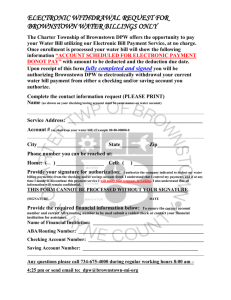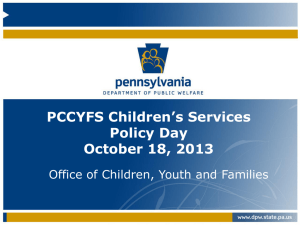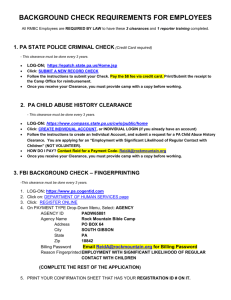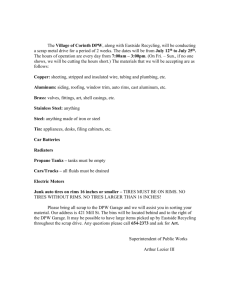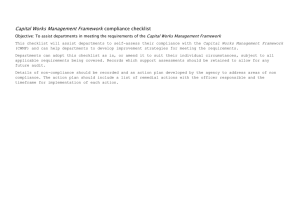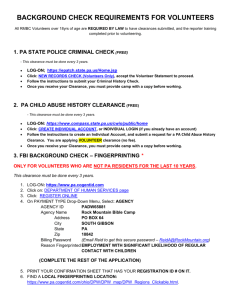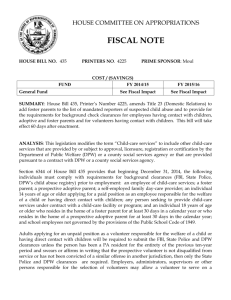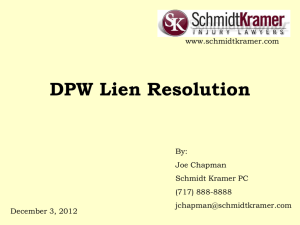Act 55 RMTF PowerPoint Presentation, dated 5/27/2014
advertisement
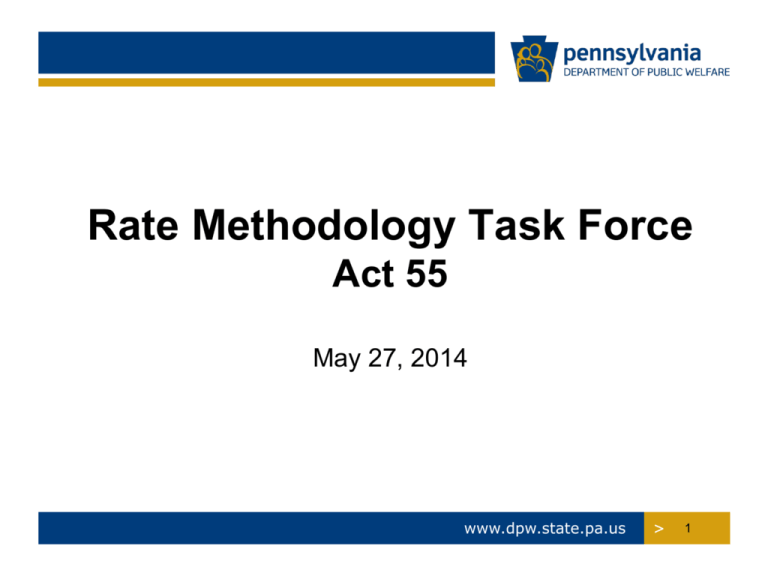
Rate Methodology Task Force Act 55 May 27, 2014 www.dpw.state.pa.us > 1 Rate Methodology Task Force Agenda for Today: • Introduction of Task Force Members • Purpose and Goals • Background • Development of the Framework • Pennsylvania Rate Methodology Framework • Recommendations • Questions & Answers www.dpw.state.pa.us > 2 The Department of Welfare Our Vision and Mission Our Vision is to see Pennsylvanians living safe, healthy and independent lives. Our Mission is to improve the quality of life for Pennsylvania’s individuals and families. We promote opportunities for independence through services and supports while demonstrating accountability for taxpayer resources. www.dpw.state.pa.us > 3 Rate Methodology Task Force Background: • The Department issued a bulletin in 2008 that mandated counties and providers to gather and forward certain fiscal information to the Department for the determination of maximum allowable Act 148 state and Title IV-E federal reimbursement. • As a result of a lawsuit by several providers, the Supreme Court of Pennsylvania determined that the Department did not have the authority to institute the process through a bulletin. • Upon issuance of the Supreme Court’s decision, the Department ceased the review of provider fiscal packets. www.dpw.state.pa.us > 4 Rate Methodology Task Force Legislation: • On July 9, 2013, Governor Tom Corbett signed House Bill 1075, now known as Act 55 of 2013 • Act 55 of 2013, in part, amended the Public Welfare Code by adding a new section, Section 704.3 • This section requires a provider to submit documentation of its cost of providing placement services to the Department and authorizes the Department to use the documentation to support the claim for federal and state reimbursement www.dpw.state.pa.us > 5 Rate Methodology Task Force Legislation: • Pursuant to Act 55 of 2013, DPW is required to convene a task force to develop recommendations for a methodology to determine reimbursement for actual and projected costs of child welfare services which are reasonable and allowable • The task force shall provide written recommendations as to the methodology for purchase of out-of-home placement services from providers and related payments to the General Assembly by April 30, 2014 • The task force shall provide written recommendations for other purchased services by December 31, 2014 www.dpw.state.pa.us > 6 Rate Methodology Task Force Development of the Framework: • • • Establishment of the steering committee Development of the charter Emphasis on the collaboration of task force members www.dpw.state.pa.us > 7 Rate Methodology Task Force Development of the Framework: • Review of other state methodologies • • Including Indiana, North Carolina, Maryland, Ohio, Colorado, California, Florida, Iowa, New York, New Jersey, Missouri, Texas, Wisconsin and Washington, DC Bureau of Financial Operations • Clarification of sub-recipients and vendors in regards to audit needs www.dpw.state.pa.us > 8 Rate Methodology Task Force Development of the Framework, continued: • Administration for Children and Families • • Determination of a methodology for Pennsylvania • • November 12, 2013 Task Force meeting Model on page 30 of the report Formation of ad hoc workgroups • • • • Cost Report/Audit Requirement Standardized Job Descriptions/Standardized Service Descriptions State Review Process County Review Process www.dpw.state.pa.us > 9 Development of the Framework Administration for Children and Families (ACF): • • • • • Provided the federal perspective to costs that are allowable for reimbursement No federal requirement for a particular methodology States set foster care rates based on the state approach and budget priorities Costs need to be identified and measured so that only Title IV-E costs are in the documents received by ACF Each provider needs to develop a methodology for capturing staff time to determine daily supervision www.dpw.state.pa.us > 10 Administration for Children & Families ACF does not direct the methodology used by states; however, the cost methodology must: • • • Describe the procedures used to identify, measure and allocate all costs to each of the programs operated by the agency Conform to the accounting principles and standards prescribed in the Uniform Administrative Requirements, Cost Principles and Audit Requirements for Federal Awards Contain sufficient information in such detail to allow the Department to make an informed judgment on the correctness and fairness of the procedures for identifying, measuring and allocating all costs to each of the programs operated by the provider agency www.dpw.state.pa.us > 11 Development of the Framework Review of other state methodologies yielded: • • • • • • • • Establishment of clear timelines for submission, review and final analysis of costs Standardization of service definitions and related staff positions and activities to support consistency and timeliness in the review and analysis of costs Utilization of a third party provider audit to better focus the role of the state in the review process Reinforcement of the value and need for individual provider and county negotiations Creation of an allowance for regional/county variations in rates reflecting geographic locations, contract specifications and county-specific requests Development of a provider cost report that supports submission of needed information in a streamlined and efficient format Standardization or clearly-defined guidance for the presentation of provider cost allocation plans Consideration of quality, outcomes and performance in the rate methodology process www.dpw.state.pa.us > 12 Pennsylvania’s Rate Methodology Key components of the Pennsylvania model: • Standardized Actual Cost Report • Standardized Service Descriptions/Standardized Job Descriptions • Role of the state—set Title IV-E and state participation • Role of the county—need for service and the reasonableness of costs • Mechanism for new providers, new services and providers licensed under Chapter 6400 Regulations • The role of measurable outcomes in the process www.dpw.state.pa.us > 13 Rate Methodology Task Force PENNSYLVANIA Guidelines for Audit Mechanism for New Providers and New Services Cost of Doing Business RAF* Audit to Address Cost Allocation Plans Independent Audit: Validate Cost Report Doing Business Role of County: Need for Service / Reasonableness of Costs NeedsBased Plan and Budget Standardized Service Descriptions/ Standardized Actual Cost Report Role of State: Set Title IV-E and State Participation Timelines Contract Negotiation Standardized Job Descriptions Foster Family Care Congregate Care Role of Quality in the Process (Outcomes) www.dpw.state.pa.us > 14 Rate Methodology Task Force County Child Welfare Agency Benefits: • • • • Assists in our partnership for assuring services are provided to our clients Assists in our partnership for assuring that taxpayer dollars are spent effectively Assures that providers will be able to serve clients we are mandated to serve Creates an improved basis for consistency in contracting www.dpw.state.pa.us > 15 Rate Methodology Task Force What Commissioners Need to Know: • • • • Standards will enhance local relationships Contracting process will improve and require less administrative time Predictability assists with local budget considerations Counties have been partners from the start www.dpw.state.pa.us > 16 Cost Report/Audit Requirements Ad Hoc Workgroup www.dpw.state.pa.us > 17 Cost Report/Audit Requirements Focus: • • Congregate Care Providers Foster Family Care Identify: • • • Total Actual Cost of Care Title IV-E Costs Act 148 Costs www.dpw.state.pa.us > 18 Cost Report/Audit Requirements Purpose: • Develop a formatted reporting structure • • • • Transparent Reasonable Allowable Which is also • • • Measurable Efficient Timely Result: • • • Concept Document/Cost Report Agreed Upon Procedures Rate Adjustment Factor www.dpw.state.pa.us > 19 Cost Report/Audit Requirements Research Conducted: • • • Review of 14 other state processes relative to federal Title IV-E funding Consultation with 4 independent CPA firms Feedback from PCCYFS (Pennsylvania Council of Children, Youth and Family Services) and YSAP (Youth Service Alliance of Pennsylvania) www.dpw.state.pa.us > 20 Cost Report/Audit Requirements How is a format transparent, reasonable and allowable? • Agreed Upon Procedures (AUP) • • Specified parties agree on the procedures and assume responsibility for sufficiency since they understand their own needs CPA firm is engaged by a client to issue a report of findings based on specific procedures performed on subject matter www.dpw.state.pa.us > 21 Cost Report/Audit Requirements Hierarchy of Agreed Upon Procedures: • • • • • • Agreed Upon Procedures A-133 Audit Yellow Book Audit Review Compilation www.dpw.state.pa.us > 22 Cost Report/Audit Requirements Concept Document/Cost Report: • Identifies: • • • • • Mechanism used to apply Agreed Upon Procedures Provider costs are consolidated into one comprehensive report • • • Actual Total Costs Actual Allowable Act 148 Costs Actual Allowable Title IV-E Costs Duplication of information reported in multiple packets is eliminated Personnel costs/FTEs will be reported by position totals only Providers also have the ability to note significant changes that occur after the reported year www.dpw.state.pa.us > 23 Cost Report/Audit Requirements Concept Document/Cost Report Exception: • New providers or new placement services that have no historical costs • • • Budget information used to calculate Total costs, Act 148 and Title IV-E participation rates No requirement for an AUP Alternative Cost Report will be developed by the Department www.dpw.state.pa.us > 24 Cost Report/Audit Requirements Concept Document/Cost Report: • Function of the Department—provide state-level oversight to ensure: • • • • • Accuracy Transparency Proper allocations Allowability Function of the 67 counties—determine the need for: • • • • Service Reasonableness Service enhancement necessity Contract negotiation www.dpw.state.pa.us > 25 Cost Report/Audit Requirements Agreed Upon Procedures: • • • CPA Firm provides validity and accuracy of the private agency’s Cost Report prior to the transfer of the Cost Report to the Department Required for the period of July 1, 2014 through June 30, 2015 Cost Reports and AUP are due December 31, 2015 Through testing and underlying support of the provider and the CPA firm, the AUP ensures: • Proper and standardized allocation of costs • Proper allowability of costs www.dpw.state.pa.us > 26 Cost Report/Audit Requirements Agreed Upon Procedures: Major areas of review for testing methods of allocation and allowable costs for Act 148 and Title IV-E: • • • • • Reconciliation of Cost Report to trial balance Payroll and fringe benefits Cash disbursement for non-payroll expenses Fixed Assets Census Statistics www.dpw.state.pa.us > 27 Cost Report/Audit Requirements Agreed Upon Procedures: Follows federal and state requirements • • • • Uniform Administrative Requirements, Cost Principles and Audit Requirements for Federal Awards PA Code 55, Chapter 3140 Social Security Act 475(4)(A) CFR Title 45, Section 1356.60 www.dpw.state.pa.us > 28 Cost Report/Audit Requirements Rate Adjustment Factor: • • A recommendation was made to use a Rate Adjustment Factor (RAF) since the concept document/Cost Report and AUP use historical costs The RAF is applied directly to the total actual costs as well as the Act 148/Title IV-E county share reimbursement rate Components of the Rate Adjustment Factor: • • Employment Cost Index (ECI)—measures the cost of labor from the Bureau of Labor Statistics Consumer Price Index (CPI)—depicts the average change in prices paid on consumer goods/services over a period of time www.dpw.state.pa.us > 29 Cost Report/Audit Requirements Rate Adjustment Factor The RAF will account for a 24-month window between actual reported costs and the year in which the rates are in effect: • Reporting Year 7/1/2014 – 6/30/2015 • Effective Year 7/1/2016 – 6/30/2017 In general, providers in the Commonwealth average 70% personnel costs and 30% non-personnel costs. Therefore, the calculation is as follows: [(70% X ECI – All Workers Factor) + (30% X CPI-U Factor)] X 2 years www.dpw.state.pa.us > 30 Cost Report/Audit Requirements Summary: • • • Develop a transparent, reasonable and allowable process through the use of historical costs Improve efficiency and timeliness of reporting cycle through the use of an AUP Recognize historical costs and use a Rate Adjustment Factor to bring costs to current value www.dpw.state.pa.us > 31 Standardized Service Descriptions/Standardized Job Descriptions Ad Hoc Workgroup www.dpw.state.pa.us > 32 Standardized Service/Job Descriptions This workgroup was configured to: • • Include both public and private agency participants Build upon the efforts of a prior workgroup Participants Included: • • • State, provider and juvenile probation office members of the RMTF Additional providers, county fiscal and state office staff Representatives of diverse foster family and congregate care programs www.dpw.state.pa.us > 33 Standardized Service/Job Descriptions Standardization of service and job descriptions supports: • • • Development of a standardized time study methodology Comparisons of costs and service outcomes Common understanding of job functions across service types “Standardization” does not ask or expect the provider community to give up individual agency features or program models. The goal is not “cookie cutter” services. www.dpw.state.pa.us > 34 Standardized Service/Job Descriptions Purpose: • • To develop standardized service descriptions and job descriptions for foster family care programs To develop standardized service descriptions and job descriptions for congregate care programs www.dpw.state.pa.us > 35 Standardized Service/Job Descriptions Outcomes include the development of: • • • Consistent and defendable foundations as the basis of claiming of state Act 148 and federal Title IV-E funds Clear and consistent program characteristics and related employee position activities Standardized characteristics and activities for select staff positions, reducing the need for extensive individual provider agency detail Standardization efforts allow self-selection of service descriptions and staff position activities that reflect agency program operations. www.dpw.state.pa.us > 36 Standardized Service/Job Descriptions How recommendations were developed: • • • • Foster family care and congregate care subgroups were created Previous effort to address standardization was the starting point Began by defining categories of foster family care and congregate care practices Consistent core characteristics common across Pennsylvania were identified www.dpw.state.pa.us > 37 Standardized Service/Job Descriptions Development of recommendations: • • • • • Characteristics of child most appropriately supported at various intervention levels were identified Desired and relevant characteristics and skills of foster parents were developed for foster family care programs Agency staff position activities addressed differences in intensity and deliverables across various categories Various configurations of care and 3 levels of staffing for congregate care categories were developed Time Study options were explored www.dpw.state.pa.us > 38 Standardized Service/Job Descriptions Diversity in staffing and administrative cost allocations did not support uniformity in defining supervisory positions. Cost allocation plans were identified as a vehicle to address supervisory activities and administrative expenses. www.dpw.state.pa.us > 39 Standardized Service/Job Descriptions Workgroup Recommendations (Administrative): That the Department approve: • • • • • • • The defined Foster Family Care categories, specific child characteristics, Foster Parent Skills and Activities and Foster Care Worker Activities The Foster Family Care categories with MA funding The defined Foster Family Care Case Manager position and related activities specific to room, board and basic supervision The defined Congregate Care categories The defined Congregate Care staff positions and activities for Congregate Care Workers Case Managers The process and funding for implementation of an RMTS or other standardized time study process for SFY 2015-16 Implementation of a time study pilot and training for providers www.dpw.state.pa.us > 40 State Review Process Ad Hoc Workgroup www.dpw.state.pa.us > 41 State Review Process Purpose: • • Develop a transparent state review process that takes into account the submission of costs and other supporting documentation for all applicable placement providers Respect of the Department’s obligation and responsibility for Title IV-E and Act 148 funds www.dpw.state.pa.us > 42 State Review Process Process Development: • • Adoption of a charter to define boundaries, goals, time frames, etc. The process is highly dependent on the Cost Report/Audit Requirements and county review process www.dpw.state.pa.us > 43 State Review Process Process: • • • • Begins with a complete submission of costs and related documents (variations—see page 47 of the report) The Department completes the review within 120 days of a complete submission Final determination of Title IV-E (if applicable) and Act 148 allowability established the reimbursement limit for federal/state participation Once the state review is completed, the county review process begins and leads to negotiations and execution of a final contract www.dpw.state.pa.us > 44 State Review Process Timelines and Deadlines: • • • Cost Reports and related documents are due December 31 for private providers and new services/programs/providers with July 1 start date Requests for 1-month extensions considered when received by November 15 Requests for 60-day extensions considered when there is delayed receipt of funding confirmation letters from counties • If granted, effective from the date the confirmation is received www.dpw.state.pa.us > 45 State Review Process Timelines and Deadlines: • • December 31 deadline only applicable to Chapter 6400 licensed programs if current client will be remaining in care Cost Reports and related documents due April 30 for county foster family care and congregate care programs • Allows for priority response to private provider submissions that require a county negotiation process www.dpw.state.pa.us > 46 State Review Process Review of Existing Private Providers: Complete submission includes: • • • • • • Completed Cost Report AUP Document with requested attachments Agency Independent Audit Program Description(s) License(s) Job description(s) as requested Cost Report allows for budgeted costs using the “optional columns” • All budgeted costs require support documentation to accurately determine allowability for Title IV-E/Act 148 funding Communication Plan to promote transparency and timeliness of the process www.dpw.state.pa.us > 47 Review of Existing Private Providers State Review Process (Routine Review): Completed annually • Review of Cost Report • Review of AUP and attachments • Review of Agency Independent Audit • Review of Program Description(s) • Review of License(s) • Review of Job Description(s) www.dpw.state.pa.us > 48 Review of Existing Private Providers State Review Process (Enhanced Review): Completed every 5 years at a minimum • All Routine Review items AND • • • Review of Agency Cost Allocation Plan Review of allocation methods for payroll Review of Agency policies pertaining to the administration of time studies www.dpw.state.pa.us > 49 Review of Existing Private Providers Transition Period (two years) Review: Validates the independent auditor’s review and determinations of Title IV-E/Act 148 allowability, establishes confidence in the process and identifies additional training needs • Similar to Enhanced Review www.dpw.state.pa.us > 50 Review of County Programs Complete submission includes: • • • • Completed Cost Report Program Description(s)—congregate care only License(s) Job description(s)—congregate care only All items are reviewed thoroughly. www.dpw.state.pa.us > 51 State Review Process Review of Chapter 6400 Programs: Complete submission includes: • Child-Specific Budget Information • Program Description(s) • License(s) • Job Description(s) All items are reviewed thoroughly. www.dpw.state.pa.us > 52 State Review Process New Services/Programs/Providers: Complete submission includes: • Completed Cost Report—budget version • Supporting Documentation • Program Description(s) • License(s) • Job description(s) / Cost Allocation Plan / Organization Chart All items reviewed thoroughly. www.dpw.state.pa.us > 53 State Review Process Training: The Department will: • Develop training curriculum for providers, independent auditors, county and state staff • Issue thorough instructions consistent with legislative mandates • Annual process for instruction revisions • Sponsor and conduct annual trainings for independent auditors, providers and county staff www.dpw.state.pa.us > 54 County Review Process Ad Hoc Workgroup www.dpw.state.pa.us > 55 County Review Process Objective: Reimburse placement service providers for actual costs that are allowable, reasonable and aligned with the counties service and level of service need. www.dpw.state.pa.us > 56 County Review Process Process: • • • • • • County reviews Standardized Cost Report Engagement with provider for questions/answers County rate proposal to provider Agreement reached, negotiation Provider cost resulting from rate agreement included in Implementation and Needs-Based Plan IF funding is approved by the Department through the Needs-Based Plan and Budget, the county can contract with providers at the rate which will cover the costs as submitted in the Needs-Based Budget www.dpw.state.pa.us > 57 County Review Process Key Dates in the Process: • • • • • Federal Funding Letters—November 1, 2014 Cost Report to DPW—December 31, 2014 County negotiations—point at which the county has access to the Cost Report, after December 31, 2014 Submission of Needs-Based Plan and Budget with costs included—September 15, 2015 Incorporation of results of the first year of the proposed methodology, contracted rates effective July 1, 2016 www.dpw.state.pa.us > 58 Recommendations Recommendation for Fiscal Year 2014-2015 • • Reimbursement amounts be extended up to 3 years (from the current 2 years) to cover SFY 2014-15 On an interim basis for SFY 2014-15, the Department would participate in the reimbursement of county-negotiated rates for services up to the state maximum allowable reimbursement amount regardless of whether another county had negotiated a lower rate for the same services. • • ACF has been supportive of a multi-year maximum allowable reimbursement amount The current process will be in effect for new providers, new services initiated by current providers and for providers who want the option to increase their maximum allowable reimbursement amounts • Providers who submit a complete submission of costs and related documents by the due date and respond to questions timely during the states review will be reimbursed based on the negotiated rate back to July 1 of the contract year www.dpw.state.pa.us > 59 Recommendations Rate Adjustment Factor: • • • The General Assembly approve a RAF as part of the overall Pennsylvania rate methodology for placement providers The application of the RAF will be applied directly to the payment and Act 148/Title IV-E/county share reimbursement rate The methodology for establishing the RAF will be reviewed annually and published by the Department www.dpw.state.pa.us > 60 Recommendations Time Study Process: • • The General Assembly consider funding to address the cost of implementation of a RMTS or other standardized time study process for provider Foster Family Care Case Managers, Congregate Care Child Care Workers and Case Managers This investment will support improved accuracy and timeliness related to submission of claims for federal funds and elevated accountability for use of state dollars www.dpw.state.pa.us > 61 Recommendations State Review Process: • • The Department be given the authority to review submission of costs and supportive documentation, AUP documents, agency audits, service descriptions, licenses and other relevant information for the purposes of validating the associated federal and state reimbursement levels The Department be given the authority to conduct enhanced provider reviews on a regular basis as continued validation of the rate methodology and the role that independent auditors have in the routine provider rate methodology process www.dpw.state.pa.us > 62 Recommendations Regulatory: A process and timeline for regulatory revisions to incorporate the proposed categories of services: • Chapter 3700 (Foster Family Care) • Chapter 3800 (Child Residential and Day Treatment Programs) • Chapter 3680 (Private Children and Youth Agency) • Clear and coordinated regulatory base defining desired alternatives for older youth including Transitional and Supervised Independent Living options www.dpw.state.pa.us > 63 Rate Methodology Task Force Questions??? www.dpw.state.pa.us > 64
